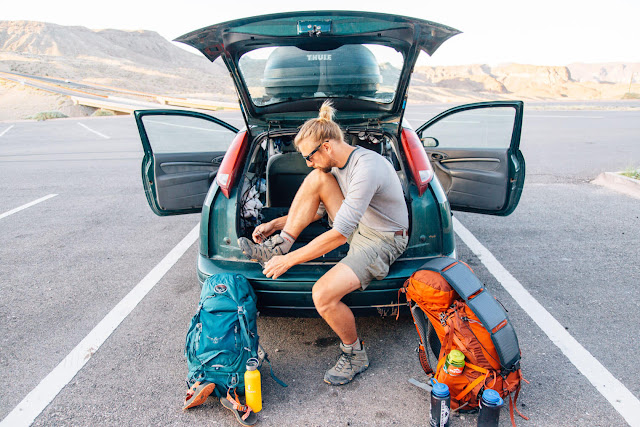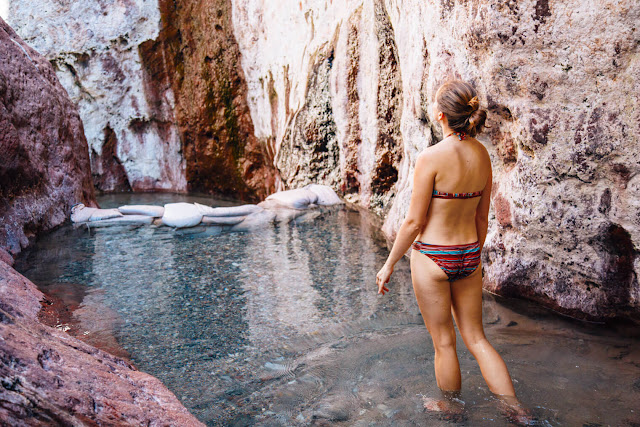Shortly after the wash, we quickly descended down into a high-walled canyon. The sun was still low enough on the horizon that this section remained almost entirely in the shade. We meandered down the the loose gravel trail for about an hour and a half before we arrived at the banks of the Colorado River. Here we had to turn left, but while one might expect the trail to follow the river, it actually cuts inland in order to get up and over a ridge.
There are signs marking the way, even though the topography makes identifying the trail a little difficult. In a few areas, we had to scramble our way up and over a narrow rocky crack in a cliff. This was a little tricky with our overnight packs, but we managed to crawl our way up. At this point the sun was getting pretty high in the sky and we were starting to get the classic backpacker back sweat. Thankfully we were nearly there
The Campground
The Hot Springs
The trail dead ends at a 20 foot waterfall, but a ladder has been rigged up so you can access the hot springs located above. While securely fastened to the cliff, the rungs of the ladder were wet and slippery, making the final dismount at the top was a little tricky.
Here at the top, is where the first of the hot springs pools begin. Gravel filled sandbags have been stacked to create artificial pools to prevent the water from just rushing down the waterfall. The first pool is the coolest, but as you progress up the canyon they get progressively warmer. The top pool, which is closest to the source, runs at about 110 F degrees.
Near the hot springs there are also signs about Naegleria Fowleri – also known as the brain-eating amoeba – which can be found in thermal pools such as these. If present, the amoeba can travel up your nasal passage and cause a fatal infection. While such infections are extremely rare, with only 130 cases being reported to the CDC since 1962, it is still advised that visitors refrain from putting their head underwater. While these hot springs are beautiful, they are wild, and a certain degree of caution must be exercised when visiting them.
Since it was a warm day to begin with, we couldn’t handle the hotter pools at the top, so we spent most of our time hanging out in the lower pools. There we reclined in the clear water and listened to the sound of the waterfall echo down the canyon. While it was very exposed down by the beach, inside the canyon we could relax in the shade. Finally after a good long soak, we headed back to camp.
Since it was a warm day to begin with, we couldn’t handle the hotter pools at the top, so we spent most of our time hanging out in the lower pools. There we reclined in the clear water and listened to the sound of the waterfall echo down the canyon. While it was very exposed down by the beach, inside the canyon we could relax in the shade. Finally after a good long soak, we headed back to camp.
What We Ate
The Souk – For dinner, we made a pot of lemon chicken with couscous. After a long day, this meal really hit the spot for us. It was super quick to make (maybe 8 minutes from start to finish) and completely filling. The dehydrated spinach got us some often neglected veggies into our diet, while the chicken provided us with some much needed protein.
Big Bend Scramble – For breakfast on the second day, we were treated to a summer sausage and egg scramble. The dehydrated egg crystals are lightweight, but when they are combined with water they create delicious tasting scrambled eggs. We’ve always been wary of powdered eggs, but these were delicious.




























0 commentaires:
Enregistrer un commentaire